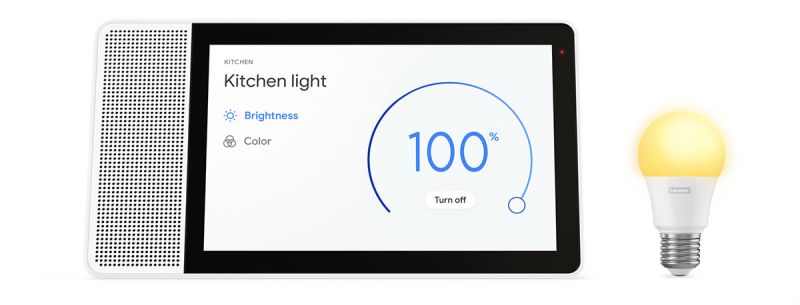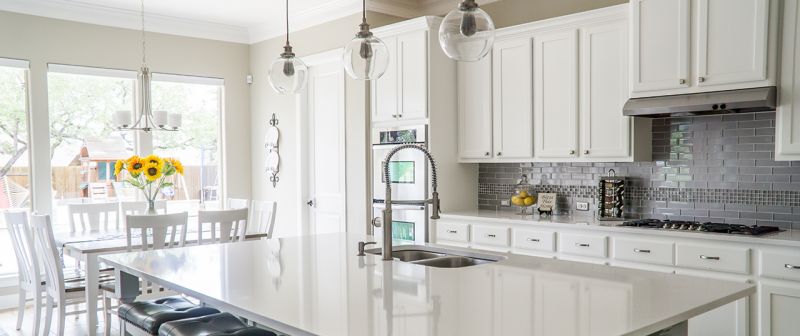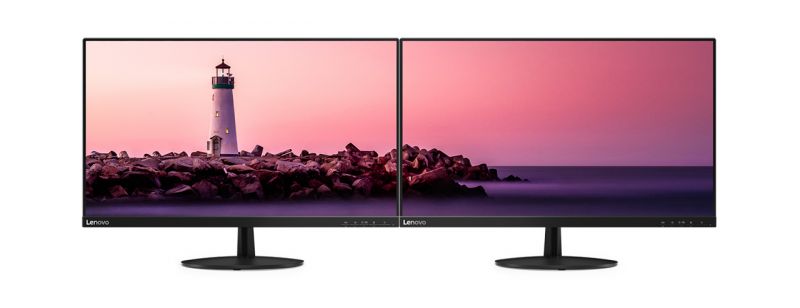Ways to transform your home into a smart home
Any one device listed here will make your home smarter. Adopt a few of them and you'll see noticeable time and energy savings.

Who knew our homes can be life-long learners? You can teach an old house new tricks. Today's ever-expanding list of smart home systems and devices gives contractors and do-it-yourselfers new options for connecting and automating—transforming, really—nearly every functional aspect of a typical home.
We hear you. Too complex, you say. Don't smart homes need custom wiring, use hard-to-read LCD keypads, and come with thick user manuals?
Not anymore. The smart home marketplace in 2018 is dramatically different, with everything from wireless switches that cost just a few dollars and can make any outlet "smart" to webcam refrigerators that let you check your milk supply while still at the store. You can install integrated systems or one-off devices. And now the new Lenovo Smart Display can help you connect and manage many smart home features from your couch.
So here you go. Any one device listed here will make your home smarter. Adopt a few of them and you'll see noticeable time and energy savings. Or take on the full list to give your smart home a graduate degree.
Smart home transformation: Security
Security is one of the most active smart home categories, along with heating and cooling and entertainment. It's likely because nearly every technology that makes smart homes so smart—Wi-Fi signals, remote sensors and actuators, video cameras, machine-learning, and so on—can play a role in protecting your home and family.
Given the category's maturity, you may already know some of these smart security features. You won't get an "F" if you haven't installed them yet, but they're worth considering:
Wondering who's at the door? Smart doorbells (also called video doorbells) already know—and let you see and talk to your visitors, too—even by smartphone. Smart door locks enable remote locking and unlocking, and some models can activate based on the proximity of your phone.
Smart security cameras let you view remote parts of your home or property and can alert you to unexpected events or intruders. They can be indoor or outdoor, always-on or motion-activated. Newer systems—such as the Lenovo Smart Camera—offer cloud storage (free or paid) so you can save more hours of video to capture what you don't see live.

Smart home transformation: Lighting
Imagine the convenience of voice-activating your interior lights as you enter the door. Or set them to turn off automatically when you leave. Or having the exterior lights come on when your smartphone senses you're nearing home each evening.
Advanced lighting solutions are some of today's brightest smart home ideas. (Yes, the puns are everywhere!) They're also some of the easiest gadgets for average homeowners to install. Here are a few that we found:
Wireless light bulbs and lighting systems are increasingly popular. They use Wi-Fi connected bulbs that screw into existing sockets (or wireless sockets with regular bulbs) and are controlled through a central hub or bridge app. Some can even change colour for specific rooms or activities.
If controlling groups of bulbs through a hub isn't the right solution for you, consider one of the many smart plugs and smart switches available today. These handy devices let you turn on/off an entire electrical outlet or wall switch and whatever's connected to it—often individually, without needing a central control hub.

Smart home transformation: Appliances
In their own way, appliances were some of the first smart devices to gain wide acceptance. There really was a time when coffee pots were turned on manually each morning, freezers didn't know when to make ice, and ovens weren't yet equipped with wireless thermometers and auto shut-offs.
Appliances are also where some of the most innovative and truly "smart" automation ideas are emerging—or being promised. Take a look at what we found:
For cleaning, there are robotic vacuums to clean the floors, smart dishwashers that monitor and maximize detergent use and smart trash cans that remind you when to empty them. Smart clothes washers have similar notification features, with some that can link to online tech support libraries.
For food prep, today's smart refrigerators have front-mounted touch screens for making lists, finding recipes, or seeing what's inside without opening the door (also viewable via smartphone). And while they shouldn't be left completely unattended, smart ovens let you adjust temperatures or turn them off remotely.

Smart home transformation: Entertainment and multimedia
Music, film and PC gaming fans are often also "gadget people," so many of you have already experimented with smart entertainment technology. Wi-Fi enabled smart TVs, for example, have made streaming movies far easier, and some models feature voice search tools to help you find a film simply by saying its name or quoting a line of dialogue.
If you haven't browsed through a technology store display area recently or kept up with your online product reviews, here's some of what you might have missed:
The latest waves in smart home entertainment aren't strictly entertainment devices at all. They're the new smart speakers and smart displays (such as the Lenovo Smart Display) that can automate tasks around the home—including when and where to play music, show video, and so on. Often these devices can replace the original TV and speaker controllers and apps.
A whole-home music set-up still requires integrated speaker devices throughout the house. The latest smart speaker systems can be set to play different songs in different rooms. And with the help of a smart speaker or display, there is even potential for integrating with presence sensors, so songs play only when someone's there to hear them.
Smart home transformation: Heating and cooling
Your home may already be smarter than you think, as nearly everyone today uses a programmable thermostat to regulate heating and cooling. It's the no-brainer of smart home automation—optimizing comfort during active hours but conserving when no one's home or late at night. You save on energy costs while you're at work or asleep.
Smart home heating and cooling technology don't stop at thermostat timers, however. Check out these helpful solutions:
How much could you save with smart window blinds that automatically close as the day gets warmer and open again when things cool down? There are also smart window shades that work similarly, and smart air vents that ensure your treated air flows to the rooms that need it most.
Learning thermostats go a step beyond programmable models. Over time they make adjustments based on what they think you'd like—such as adding heat on unexpectedly cold mornings (based on local weather readings). Some systems also can adjust temperatures using sensors that determine which rooms are occupied.

Smart home transformation: Landscaping and lawn care
In some areas, conserving local water resources is a public priority, and the cost of water can rival that of electricity. So landscaping and irrigation is fertile ground (there we go with the puns again!) for smart home technology. Plus, some of these tools can help you achieve real labour savings, so you can spend more time enjoying your surroundings than maintaining them.
Here's some of what we found to help you manage your landscaping from the comfort of a lawn chair or hammock:
Smart irrigation controllers work with more traditional timers and flow controls to adjust the daily watering volume to match local conditions, based on either direct on-site readings or using free or paid feeds of local weather data. Some models include rain gauges, so they can suspend watering in unexpected weather.
They can't yet handle a farm or public park, but today's smart lawn mowers can easily trim the grass on a small suburban home lot. Though pricey, once you help them learn your lot dimensions (they're not quite as automatic as robotic vacuums) you can pre-set mowing times and—because they're so quiet—run them at virtually any hour of the day.

Smart home transformation: Pet care
Yeah, yeah, your Fido and Fifi are the already the smartest dog and cat in the world. And that's OK because smart home pet products aim to make pets happier and healthier by making their owners smarter.
It's a broad category, with solutions for dogs, cats, hamsters, and nearly every other companion animal we keep in our homes. Here's a sampling of some of today's most interesting smart home devices for pets and their people:
Smart pet doors let you give your pets outdoor access at regular times each day or as-needed via remote app control. Some even have sensors that can detect a collar fob (or your pets subdermal microchip) to make certain only YOUR pet goes out—or, more importantly, comes in.
Feeding time gets easier with smart pet bowls. Built-in scales can help prevent over-feeding by alerting you when you drop in too much food. Or, for finicky eaters, you can get a smartphone notification when the bowl is finally empty. Some models also track the volume of food dispensed over time to remind you when to buy more.
